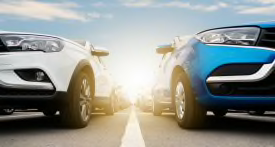Let’s cut to the chase: The Fisker Ocean was never developed enough to be sold to the public. In so many ways this fully-electric luxury SUV is an unfinished product, from the tuning of the power delivery to the soft and floaty—yet also rough and unsettled—ride, to the befuddling controls, to the number of active safety and driver assistance features that either didn’t work, or worked sporadically, on our test vehicle. Plus, some aspects of interior quality are below the standards of even budget cars and the number of creaks and rattles that you hear much of the time aren’t the least bit confidence-inspiring about the vehicle’s longevity.
Sure, the Ocean has a few novel features, like a pull-out taco tray and a “California Mode” that automatically opens nearly every panel of glass on the vehicle, including the rear window. And with 468 horsepower from its dual electric motors, the Ocean can produce decent speed (provided you nearly floor the accelerator pedal), plus the rear seat is spacious and comfortable. But these qualities don’t even begin to compensate for the lack of substance within. And that’s without even factoring in all the software, mechanical, and service woes we dealt with on our test car.
The result is that the Ocean’s road-test score puts it at the bottom of the electric SUV category—by a long margin. And after factoring in other important aspects such as predicted reliability from a company with no established records, the Ocean has one of the lowest Overall Scores we’ve recorded.
“This is the most incomplete car I’ve driven in my career, and that includes pre-production models,” said one of our longest-tenured testers. For example, it’s inexcusable that active safety and other features promised on the Ocean’s window sticker come and go, with their absences only occasionally accompanied by warning messages to let the driver know they aren’t available.
“If there was an argument for not buying the first model year of a vehicle, the Fisker Ocean is it,” said one of our testers. “It feels like the development was left unfinished before it went into production.”
And now it appears the SUV’s development will never be finished, as the Fisker Group, Inc. has filed for Chapter 11 bankruptcy.
The Ocean proves just how hard it is to build a car company from scratch. It was hard for Preston Tucker in 1948, it was hard for John DeLorean in 1982, and it was hard for Henrik Fisker the first time around in 2012 when the Fisker Karma we purchased broke down before we could test it. It’s also why success stories like Tesla and Rivian are so impressive by comparison.
We bought a 2023 Fisker Ocean Ultra for $63,981—anonymously (as we do with every vehicle that goes through our program) through the Fisker online process—for the purpose of this road test review. Since then, the company filed for bankruptcy and production has stopped.
The Ocean produces an impressive 468 horsepower from its dual electric motors, which give it all-wheel drive. But you’d guess it makes maybe half that amount when you step on the accelerator pedal from a stop. That’s because you have to press further on the accelerator pedal just to get going than in any other EV we’ve driven.
The huge power delay makes drivers feel vulnerable when having to cross an intersection, for example. Plus, even after the Ocean does finally get moving, you still have to nearly floor the accelerator pedal to achieve any real speed; again, this is very unlike all other EVs we’ve driven. That’s why the Ocean’s mighty-quick 4.1-second sprint from 0 to 60 mph is almost irrelevant. Further, when the vehicle gives you its full might, the prodigious power easily overwhelms the all-wheel-drive system (causing noticeable front wheelspin), especially in situations where you’re taking off from a stop with some vigor while also turning onto another road.
The default regenerative-braking setting decelerates the vehicle so abruptly and with such force when you release pressure on the accelerator pedal that it’s difficult to drive the Ocean smoothly—it’s likely to make your passengers feel seasick. And the way the Ocean rolls backward if you release the brake pedal while stopped at a traffic light on a slight slope is another major flaw you’ll have to contend with.
Driving range is pegged at 350 miles by the EPA. And while the Ocean Ultra fell far short of that mark in our 70-mph highway range test, only managing 293 miles, that’s still a solid distance among current EVs. Unfortunately, home-charging the large 113-kilowatt-hour battery is on the slow side, capable of only about 20 miles of range gained per hour of charging.
The Ocean turns into corners with some quickness, but its soft, unrefined suspension can’t cope with mid-corner bumps; they totally upset the car, causing it to sway back and forth. Also not helping matters is that the steering is completely devoid of feedback to the driver about the texture of the road or tire grip. That said, it acquitted itself well in our avoidance-maneuver exercise where it posted a commendable speed of 54.5 mph. But the inconsistent nature of the electronic stability control (ESC) made it a handful when we pushed it hard around our road course. Stopping distances were short but the brake pedal is tricky to modulate. It feels initially unresponsive and spongy as you press down on it, then becomes too touchy toward the end of its travel.
The Ocean feels soft and somewhat comfortable as you first drive down the road, but it doesn’t take long for hard hits to punch through into the cabin, which isn’t helped by our test car’s optional low-profile 22-inch tires (the Ultra comes standard with 20s). Besides the abrupt impacts, the Ocean jostles occupants side-to-side, and we noticed some jittery sensations when encountering multiple small ripples in a row. EVs are usually quiet but wind noise is quite pronounced on the highway and the low-speed pedestrian warning sound is obnoxious.
The Ocean’s cabin has some nice materials here and there, such as the suede trim on the dashboard and the doors, along with a nicely padded dash. But much of the rest of the cabin comes across as cheap and poorly put together, including the low-quality feel of the flimsy plastic bits. Few things feel solidly put together.
Oddly, and in spite of the Ocean’s nearly $64,000 as-tested price, the seats are covered with a cheap-looking cloth (rather than leather, or even fake-leather) and the driver’s seat lacks any kind of lumbar adjustment or the ability to tilt the leading edge of the bottom cushion up and down to help dial in leg support—all features typically found on vehicles at this price, and in some cases, half the price. Still, while no one loved the Ocean’s front seats, most of our drivers said their shape worked for them and they were comfortable enough, although the side bolsters are soft and give way during hard cornering. The driving position is one aspect that Fisker got mostly right, thanks to plentiful headroom, minimal right-knee intrusion from the center console, and a well-placed left footrest. But the steering wheel doesn’t have enough tilt and telescope adjustment range, especially for taller drivers.
The rear seat is roomy, and the flat floor provides impressive foot space, allowing passengers to stretch their legs out, which also aids under-leg support. That’s needed, because the seat’s low proximity to the floor results in a lack of thigh support if you have your feet flat on the floor, especially for longer-legged passengers. The seatback is at a fairly comfortable rake, which is a good thing, because it can’t be adjusted—unlike in many SUVs.
The Ocean’s massive center infotainment display and small driver’s instrument screen have a clean look and avoid the use of excess graphics, but the space for both is poorly utilized. For example, the section of the center screen for the navigation system is given just a small area, which forces the driver to glance away from the road for too long to decipher it. And even though the center screen has lots of empty space, the buttons, icons, and text are oddly small and therefore difficult to target. The center screen also suffers from severe lag—it takes seemingly forever to boot up when you first get in.
Many of the Ocean’s controls are poorly labeled and common tasks require multiple steps. For instance, the dashboard air vents have to be adjusted through the screen—you can’t physically move them with your hand. We also found it distracting that the background of the driver’s instrument screen flickers back and forth between blue and red, in an effort to indicate to the driver what is happening with the regenerative-braking system.
Phone-pairing via Bluetooth was often unstable, and neither Android Auto nor Apple CarPlay are compatible with the Fisker. Even closing the door after you get in the car is inconvenient, as the tiny door-pull is situated too far away.
Active safety and driver assistance
Standard active safety and driver assistance features on the Ocean include automatic emergency braking with pedestrian and cyclist detection, automatic emergency braking that operates at highway speeds, blind spot warning, lane departure warning, and lane keeping assistance. Rear cross traffic warning is only available on the top Extreme trim.























